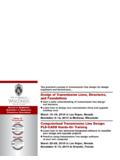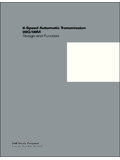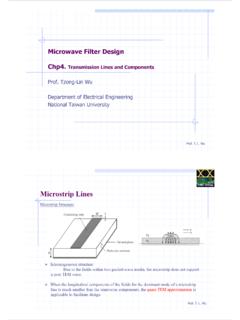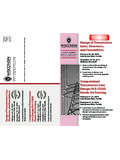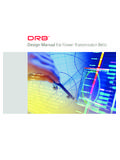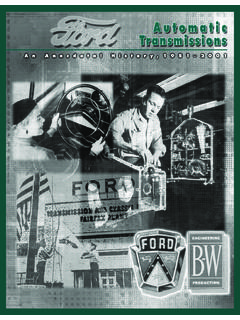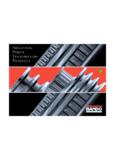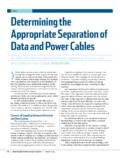Transcription of The RS-485 Design Guide (Rev. C) - Texas …
1 1 SLLA272C Febuary2008 RevisedOctober2016 SubmitDocumentationFeedbackCopyright 2008 2016,TexasInstrumentsIncorporatedThe RS-485 DesignGuideApplicationReportSLLA272C Febuary2008 RevisedOctober2016 The - InterfaceABSTRACTAs a shortcompendiumfor successfuldatatransmissiondesign,this applicationreportdiscussestheimportantas pectsof the trademarksare the propertyof 1983,the ElectronicsIndustriesAssociation(EIA)app roveda new usagein industrial,medical,and consumerapplications,RS-485has becomethe industry s applicationreportpresentsdesignguideline sfor engineersnew to the RS-485standardthat can helpthemaccomplisha robustand reliabledatatransmissiondesignin the shortesttime applicationreportpresentsdesignguideline sfor engineersnew to the RS-485standardthat can helpthemaccomplisha robustand reliabledatatransmissiondesignin the shortesttime FeaturesRS-485is an contrastto completeinterfacestandards,whichdefineth efunctional,mechanical,and electricalspecifications,RS-485only definesthe electricalcharacteristicsofdriversand receiversthat couldbe usedto implementa standard,however,is intendedto be referencedby higherlevelstandards,suchas DL/T645,forexample,whichdefinesthe communicationprotocolfor electronicenergy-metersin China,specifyingRS-485 as the featuresof RS-485are.
2 Balancedinterface Multipointoperationfroma single5-V supply 7-V to +12-Vbus common-moderange Up to 32 unit loads 10-Mbpsmaximumdatarate (at 40 feet) 4000-footmaximumcablelength(at 100 kbps)3 NetworkTopologyThe RS-485standardssuggeststhat its nodesbe networkedin a daisy-chain,also knownas partyline orbus topology(seeFigure1. In this topology,the participatingdrivers,receivers,and transceiversconnectto a maincabletrunkvia interfacebus can be designedfor full-duplexor half-duplextransmission(seeFigure2).+ 200 mV- 200 mV+ V- VDRRTRT from Masterto Febuary2008 RevisedOctober2016 SubmitDocumentationFeedbackCopyright 2008 2016,TexasInstrumentsIncorporatedThe RS-485 DesignGuideFigure1. RS-485 Bus StructureThe full-dupleximplementationrequirestwo signalpairs,(fourwires),and full-duplextransceiverswithseparatebus accesslinesfor transmitterand nodeto simultaneouslytransmitdataon one pair whilereceivingdataon the Full-Duplexand Half-DuplexBus Structuresin RS-485In half-duplex,only one signalpair is used,requiringthe drivingand receivingof datato occurat controlledoperationof all nodesvia directioncontrolsignals,suchas Driver/ReceiverEnablesignals,to ensurethat only one driveris activeon the bus at any driveraccessingthe bus at the sametime leadsto bus contention,which,at alltimes,mustbe differentialoutputof a V acrossa 54- load,whereasstandardconformreceiversdete cta differentialinputdownto 200 mV.)
3 The two valuesprovidesufficientmarginfor a reliabledatatransmissionevenunderseveres ignaldegradationacrossthe cableand robustnessis the mainreasonwhy RS-485is well suitedfor long-distancenetworkingin RS-485 SpecifiedMinimumBus SignalLevels5 CableTypeRS-485applicationsbenefitfromdi fferentialsignalingovertwisted-paircable ,becausenoisefromexternalsourcescoupleeq uallyinto bothsignallinesas common-modenoise,whichis rejectedby the of the sheathed,unshielded,twisted-pairtype,(UT P),with a characteristicimpedanceof 120 W and 22 24 showsthe cross-sectionof a four-pair,UTPcabletypicallyusedfor two ,in two-pairand single-pairversions,are availabletoaccommodatethe low-costdesignof v x c10 RTRT120W220pF60W220pF120W60W60W60 WConductorInsulationCable ShieldSheathCable :Type :Impedance :Capacitance :Velocity :Belden 3109A4 - pair, 22 AWG PLCT /CM120W11 pF/ft78% ( ns /ft) Terminationand StubLength3 SLLA272C Febuary2008 RevisedOctober2016 SubmitDocumentationFeedbackCopyright 2008 2016,TexasInstrumentsIncorporatedThe RS-485 DesignGuideFigure4.
4 Exampleof RS-485 CommunicationCableBeyondthe networkcabling,it is mandatorythat the layoutof printed-circuitboardsand the connectorpinassignmentsof RS-485equipmentmaintainthe electricalcharacteristicsof the networkby keepingbothsignallinescloseand equidistantto Terminationand StubLengthDatatransmissionlinesshouldalw aysbe terminatedand stubsshouldbe as shortas possibleto avoidsignalreflectionson the line. Properterminationrequiresthe matchingof the terminatingresistors,RT, tothe characteristicimpedance,Z0, of the RS-485standardrecommendscableswith Z0= 120 W, the cabletrunkis commonlyterminatedwith 120-Wresistors,one at eachcableend (seeFigure5, left).Figure5. ProperRS-485 TerminationsApplicationsin noisyenvironmentsoftenhavethe 120- resistorsreplacedby two 60- , low-passfilterstoprovideadditionalcommon -modenoisefiltering,(seeFigure5, right).It is importantto matchthe resistorvalues,(preferablywith 1% precisionresistors),to ensureequalrollofffrequenciesof ,( ,20%),causethe filter cornerfrequenciesto differand common-modenoiseto beconvertedinto differentialnoise,thus compromisingthe receiver s electricallengthof a stub,(the distancebetweena transceiverand cabletrunk),shouldbe shorterthan1/10of the driver s outputrise time,and is giventhrough:(1)Where: LStub= maximumstub length(ft) tr= driver(10/90)rise time (ns) v = signalvelocityof the cableas factorof c c = speedof light ( x 108ft/s).
5 Table1 lists the maximumstub lengthsof the cablein Figure4, (78%velocity),for x (1/ 375 4 / Z )=+ Febuary2008 RevisedOctober2016 SubmitDocumentationFeedbackCopyright 2008 2016,TexasInstrumentsIncorporatedThe RS-485 DesignGuideTable1. StubLengthVersusRiseTimeDEVICESIGNALRATE [kbps]RISETIMEtr[ns]MAXIMUMSTUBLENGTH[ft ]SN65 HVD1210001007SN65 LBC18425025019SN65 HVD3082E20050038 NOTE:Driverswith long rise timesare well suitedfor applicationsrequiringlong stub lengthsandreduced, a receiver s abilityto assumea determinedoutputstatein the absenceof an lead to the loss of signal(LOS) , causedby a wire breakor by the disconnectionof a transceiverfromthe , causedby an insulationfault connectingthe wiresof a differentialpair to , occurringwhennoneof the bus driversis causeconventionalreceiversto assumerandomoutputstateswhentheinputsign alis zero,moderntransceiverdesignsincludebias ingcircuitsfor open-circuit,short-circuit,andidle-busfa ilsafe,that forcethe receiveroutputto a determinedstate,underan drawbackof thesefailsafedesignsis theirworst-casenoisemarginof 10 mV only,thus requiringexternalfailsafecircuitryto increasenoisemarginfor applicationsin externalfailsafecircuitconsistsof a resistivevoltagedividerthat generatessufficientdifferentialbusvoltag e,to drivethe receiveroutputinto a ensuresufficientnoisemargin,VABmustinclu dethe maximumdifferentialnoisemeasuredin additionto the 200-mVreceiverinputthreshold,VAB=200 mV + VNoise.
6 (2)For a minimumbus voltageof , (5 V 5%),VAB= , and Z0= 120 W, RByields528 523-Wresistorsin seriesto RTestablishesthe failsafecircuitshownin ExternalIdle-BusFailsafeBiasing8 Bus LoadingBecausea driver'soutputdependson the currentit mustsupplyinto a load,addingtransceiversandfailsafecircui tsto the bus increasesthe total load estimatethe maximumnumberofbus loadspossible,RS-485specifiesa hypotheticaltermof a unit load (UL),whichrepresentsa loadimpedanceof approximately12 kW. Standard-compliantdriversmustbe able to drive32 of s transceiversoftenprovidereducedunit loading,suchas 1/8 UL, thus allowingtheconnectionof up to 256 transceiverson the Rate [Mbps]CableLength [m]321 STANDARDFAILSAFE32 UL20 ULNUL per transceiver-= Length5 SLLA272C Febuary2008 RevisedOctober2016 SubmitDocumentationFeedbackCopyright 2008 2016,TexasInstrumentsIncorporatedThe RS-485 DesignGuideBecausefailsafebiasingcontrib utesup to 20 unit loadsof bus loading,the maximumnumberoftransceivers,N, is reducedto:(3)Thus,whenusing1/8-ULtransce ivers,it is possibleto connectup to a maximumof 96 devicesto the LengthThe maximumbus lengthis limitedby the transmissionline lossesand the signaljitter at a a jitter of 10%or moreof the baudperiod,Figure7showsthe cablelengthversusdatarate characteristicof a conventionalRS-485cablefor a 10%signaljitter.
7 (1)Section1 of the graphpresentsthe areaof high ,the lossesof thetransmissionline can be neglectedand the datarate is mainlydeterminedby the driver s rise standardrecommends10 Mbps,today s fast interfacecircuitscan operateat dataratesof up to 40 Mbps.(2)Section2 showsthe transitionfromshortto long lossesof the transmissionlineshaveto betakeninto ,with increasingcablelength,the datarate mustbe rule of thumbstatesthat the productof the line length[m] timesthe datarate [bps]shouldbe < 107. This rule is far moreconservativethantoday's cableperformanceand will thereforeshowless lengthat a givendatarate thanthegraphpresents.(3)Section3 presentsthe lowerfrequencyrangewherethe line resistance,and not the switching, ,the cableresistanceapproachesthe valuefo the voltagedividerdiminishesthe signalby -6 dB. For a 22 AWGcable,120 W, UTP,this occursat CableLengthVersusDataRate10 MinimumNodeSpacingThe RS-485bus is a distributedparametercircuitwhoseelectric alcharacteristicsare primarilydefinedbythe distributedinductanceand capacitancealongthe physicalmedia,whichincludesthe interconnectingcablesand the bus in the formof devicesand theirinterconnectionslowersthe bus impedanceand causesimpedancemismatchesbetweenthe mediaand the loadedsectionof the bus.
8 Inputsignalsarrivingat thesemismatchesare partiallyreflectedbackto the signalsourcedistortingthe validreceiverinputvoltagelevelduringthe first signaltransitionfroman outputdriveranywhereon the bus requiresa minimumloadedbus impedanceof Z > x Z0, whichcan be achievedby keepingthe minimumdistance,d, betweenbus nodes:40506070800 .50 .40 .30 .20 .10 Dis tan ce (m)Media - Distributed Capacitance - (pF /m )10060402010CL( pF ) x C '>Groundingand Febuary2008 RevisedOctober2016 SubmitDocumentationFeedbackCopyright 2008 2016,TexasInstrumentsIncorporatedThe RS-485 DesignGuide(4)WhereCLis the lumpedload capacitanceand C, the mediacapacitance(cableor PCBtrace)per MinimumNodeSpacingWithDeviceand MediaCapacitanceEquation4 presentsthe relationshipfor the minimumdevicespacingas a functionof the distributedmediaand lumped-loadcapacitance;Figure8 showsthis line circuitbus pins,connectorcontacts,printed-circuitbo ardtraces,protectiondevices,and any otherphysicalconnectionsto the trunkline as long as thedistancefromthe bus to the transceiver(the stub)is the individualcapacitancecontributions:5-V transceiverstypicallypossessa capacitanceof 7 pF, whereas3-V transceivershaveapproximatelytwicethat capacitanceat 16 pF.
9 Boardtracesadd to pF/cmdependingon suppressiondevicecapacitancecan vary pF/mfor low capacitance,unshielded,twisted-paircable to 70 pF/mfor IsolationWhendesigninga remotedatalink, the designermustassumethat largegroundpotentialdifferences(GPD) as common-modenoise,Vn, to the the totalsuperimposedsignalis withinthe receiver s inputcommon-moderange,relyingon the localearthgroundas a reliablepathfor the returncurrentis dangerous(seeFigure9a).LocalProcessingCi rcuitSMPSVREGXCVRL ocalProcessingCircuitSMPSVREGXCVRL1N1PE1 L2N2PE2 SupplyIsolatorSignalIsolator23 GPDVcc1 Vcc2 Electrical Installation123 VnVcc1 Vcc2 Electrical Installation123 VnVcc1 Vcc2 Electrical Installation123 Vnhigh loop currentlow loop current100O100 OGround loopGround loopa)b)c) Isolation7 SLLA272C Febuary2008 RevisedOctober2016 SubmitDocumentationFeedbackCopyright 2008 2016,TexasInstrumentsIncorporatedThe RS-485 DesignGuideFigure9. DesignPitfallsto be Awareoff: a) HighGPD,b) HighLoopCurrent,c) ReducedLoopCurrent,Yet HighlySensitiveto InducedNoiseDue to LargeGroundLoopBecauseremotenodesare likelyto drawtheirpowerfromdifferentsectionsof the electricalinstallation,modificationto the installation,( ,duringmaintenancework),can increasethe GPDto the extentthatthe receiver s inputcommon-moderangeis ,a datalink workingtodaymightceaseoperationsometimei n the directconnectionof remotegroundsthroughgroundwire also is not recommended(seeFigure9b),as this causeslargegroundloop currentsto coupleinto the datalinesas allowfor a directconnectionof remotegrounds,the RS485standardrecommendsthe separationofdevicegroundand localsystemgroundvia the insertionof resistors(Figure9c).
10 Althoughthis approachreducesloop current,the existenceof a largegroundloop keepsthe datalink sensitiveto noisegeneratedsomewhereelse alongthe ,a robustdatalink has not approachto tolerateGPDsup to severalkilovoltsacrossa robustRS-485datalink and overlongdistanceis the galvanicisolationof the signaland supplylinesof a bus transceiverfromits localsignaland supplysources(seeFigure10).Figure10. Isolationof TwoRemoteTransceiverStationsWithSingle-G roundReferenceIn this case,supplyisolators,suchas isolatedDC/DCconverters,and signalisolators,suchas digital,capacitiveisolators,preventcurre ntflow betweenremotesystemgroundsand avoidthe showsthe detailedconnectionof only two transceivernodes,Figure11 givesanexamplefor multiple, transceiversbut one connectto the bus via the left providesthe single-groundreferencefor the DGND2 Vcc3R Febuary2008 RevisedOctober2016 SubmitDocumentationFeedbackCopyright 2008 2016,TexasInstrumentsIncorporatedThe RS-485 DesignGuideFigure11.










